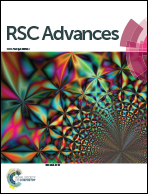Colorimetric sensing of melamine using colloidal magnetically assembled molecularly imprinted photonic crystals
Abstract
A visually perceptible, highly selective and structurally simple colorimetric sensor for melamine (MEL) based on colloidal magnetically assembled molecularly imprinted photonic crystals (MIPCs) has been constructed. The color of the MIPCs red-shifted significantly as the MEL concentration increased. The largest redshift could reach 200 nm, and the detection limit for MEL was 10−5 mg mL−1.


 Please wait while we load your content...
Please wait while we load your content...